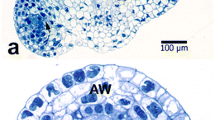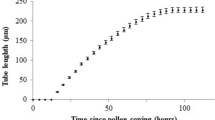Summary
The metabolism of P-particles (polysaccharide particles) was investigated in mature pollen grains ofEryngium campestre L. Numerous P-particles, originating from dictyosome activity, are found to be accumulated near the apertures, followed by mitochondria. A single layer of ER profiles seems to prevent the fusion of the P-particles with the intine. Instead of this, they fuse with each other forming nonmembrane-bounded polysaccharide-aggregates, which subsequently change their granulated structure to an amorphous. Mitochondria together with small vesicles are involved in the conversion-process. The so formed wall precursors pass through the ER and fuse into the intine.
Similar content being viewed by others
References
Catesson A-M (1973) Observations cytochimiques sur les tubes criblés de chelques Angiospermes. J Microscopie 16: 95–104
Cerceau-Larrival M-Th, Challe J (1986) Biopalynology and maintenance of germination capacity of stored pollen in some angiosperm families. In:Blackmore, Ferguson IK (eds) Pollen et spores: form and function. Academic Press, London, pp 151–164 (Linnean Society symposium series 12)
Cresti M, Pacini E, Ciampolini F, Sarfetti G (1977) Germination and early tube developmentin vitro ofLycopersicum peruvianum pollen: ultrastructural features. Planta 136: 239–247
—,Ciampolini F, Pacini E, Sarfetti G, Donini B (1979) Ultrastructural features ofPrunus avium L. pollen tubein vivo. I. The compatible pollen tube. Caryologia 32: 433–440
— —,Mulcahy DLM, Mulcahy G (1985) Ultrastructure ofNicotiana alata pollen, its germination and early tube formation. Am J Bot 72: 719–727
Esau K, Chaedle VI, Risley EB (1962) Development of sieve-plate pores. Bot Gaz 123: 233–243
Gunning BES, Steer MW (1977) Biologie der Pflanzenzelle. Ein Bildatlas. G Fischer, Stuttgart New York, pp 62–63
Hanson JB, Day DA (1980) Plant mitochondria. In:Stumpf PK, Conn EE (eds), The biochemistry of plants, vol 1, the plant cell. Academic Press, New York, pp 315–358
Heslop-Harrison J (1979) Aspects of the structure, cytochemistry and germination of the pollen of rye (Secale cereale L.). Ann Bot 44 [Suppl] 1: 1–47
—,Heslop-Harrison Y (1982) The growth of the grass pollen tube: 1. Characteristics of the polysaccharide particles (“P-particles”) associated with apical growth. Protoplasma 112: 71–80
Horner HT, Pearson CB (1978) Pollen wall and aperture development inHelianthus annuus (Compositae: Heliantheae). Am J Bot 65: 293–309
Miki-Hirosige H, Nakamura S (1982) Process of metabolism during pollen tube wall formation. J Electron Microsc 31: 51–62
Reiss H-D, McConchie CA (1988) Studies ofNajas pollen tubes. Fine structure and the dependence of chlorotetracycline fluorescence on external free ions. Protoplasma 142: 25–35
Sievers A, Schnepf E (1981) Morphogenesis and polarity of tubular cells with tip growth. In:Kiermayer O (ed) Cytomorphogenesis in plants. Springer, Wien New York, pp 265–299 (Alfert M,Beermann Wet al (eds) Cell biology monographs, vol 8)
Spurr AR (1969) A low-viscosity epoxy resin embedding medium for electron microscopy. J Ultrastruct Res 26: 31–43
Thiéry J-P (1967) Mise en évidence des polysaccharides sur coupes fines en microscopie électronique. J Microsc 6: 987–1018
Van der Wounde WJ, Morré DJ, Bracker CE (1971) Isolation and characterization of secretory vesicles in germinated pollen ofLillium longiflorum. J Cell Sci 8: 331–351
Author information
Authors and Affiliations
Rights and permissions
About this article
Cite this article
Weber, M. Metabolism of P-particles (polysaccharide particles) in mature pollen grains ofEryngium campestre L. (Apiaceae). Protoplasma 146, 65–71 (1988). https://doi.org/10.1007/BF01405914
Received:
Accepted:
Issue Date:
DOI: https://doi.org/10.1007/BF01405914




